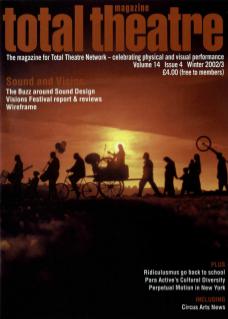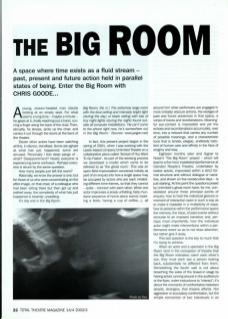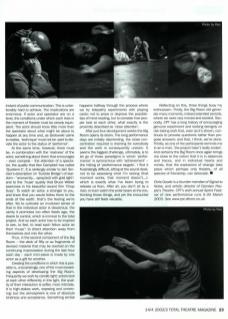A young, shaven-headed man stands looking at an empty seat. For what seems a long time – maybe a minute – he gazes at it, finally reaching out a hand, running a finger along the back of the chair. Then, abruptly, he stoops, picks up the chair, and carries it out through the doors at the back of the theatre.
Eleven other actors have been watching all this, in silence, transfixed. Some are aghast at what has just happened; some are amused. Personally I feel deep pangs of – what? Disappointment? Nearly everyone is experiencing some confusion. Perhaps everyone is struck by the same question.
How many people just left the room?
Rationally, we know the answer is one: but for those of us who were concentrating on the after-image, on that chair, of a colleague who had been sitting there but then got up and walked away, the complexity of what has just happened is bizarrely unsettling.
It's day one in the Big Room.
'Big Room, the /n/ The extremely large room with the blue ceiling and intensely bright light (during the day) or black ceiling with lots of tiny night-lights (during the night) found outside all computer installations. “He can't come to the phone right now, he's somewhere out in the Big Room."' (Source: www.jargon.net)
In fact, this present project began in the spring of 2001, when I was working with the Leeds-based company Unlimited Theatre on a collaborative piece called Scream If You Want To Go Faster. As part of the devising process we developed a model which came to be referred to as ‘the ghost room'. This was an open-field improvisation conceived initially as part of an enquiry into how a single space may be occupied by actors who are each inhabiting different time frames, so that they cannot – quite – connect with each other. While one actor improvises a slowly unfolding, fairly mundane sequence of home-alone events (reading a book, having a cup of coffee...), all around him other performers are engaged in more (initially) obscure actions, the vestiges of past and future presences in that space, a vortex of traces and reverberations. Meaningful eye-contact is impossible and yet the echoes and recombinations accumulate, over time, into a network that carries any number of possible meanings, and a characteristic tone that is tender, elegiac, endlessly redolent of human care and affinity in the face of enigma and loss.
Eighteen months later and Signal to Noise's ‘The Big Room' project – which will lead to a five-hour installation/performance at Camden People's Theatre, undertaken by twelve actors, improvised within a strict formal structure and without dialogue or narrative, and shown on five consecutive days – is just starting. At this point the questions posed by Unlimited's ghost room have, for me, constellated around three principal points of enquiry: how to hold the individual gesture or moment of interaction open in such a way as to make it readable in a multiplicity of ways; how to preserve within the performance space the memory, the trace, of past events without recourse to an imposed narrative; and, perhaps most importantly, how the individual actor might make interventions within a performance event so as to not draw attention, but rather give it away.
This last question is the key to much that I'm trying to achieve.
When an actor and a spectator in the Big Room (and in the conception of theatre that the Big Room indicates) catch each other's eye, they must each see a person looking back, substantially no different from them. Demolishing the fourth wall is not about breaching the sides of the boxed-in stage by having actors running around in the auditorium or the foyer, under instructions to ‘interact'; it's about the moments of confrontation between people, strangers, that theatre affords. Not aggressive or accusatory confrontation, but the simple connection of two individuals in an instant of public communication. This is unbelievably hard to achieve. The implications are enormous. If actor and spectator are on a level, the conditions under which each lives in the moment of theatre must be closely equivalent. The actor should know little more than the spectator about what might be about to happen at any time and, as Grotowski came to realise, ‘technique' must not be used to elevate the actor to the status of ‘performer'.
At the same time, however, there must be, in combination with the 'realness’ of the actor, something about them that encourages – even compels – the attention of a spectator, the quality that Ken Campbell has called 'Quotient X'. It is strikingly similar to Iain Sinclair's description (in Suicide Bridge) of stardom – 'anonymity... spray[ed] with gold light’ and to the 'muse' quality that Bruce Weber examines in his beautiful recent film Chop Suey. To watch an actor, a stranger to you, and know that you would follow them to the ends of the earth: that's the feeling we're after. Yet to cultivate an involuted sense of that in the individual actor is disastrous: the vanity it promotes too often feeds ego, the desire to control, which is inimical to the total project. And so each actor has to be inspired to see, to feel, to read each fellow actor as their 'muse': to direct attention away from themselves and into the other.
Thus, in the second component of the Big Room – the deck of fifty or so fragments of devised material that may be overlaid on the continuing improvisation during the last hour each day – each mini-piece is made by one actor as a gift for another.
Creating the conditions in which this is possible is, unsurprisingly, one of the most rewarding aspects of developing the Big Room. Frequently we work by candle-light; actors look at each other differently in this light, the quality of their interaction is softer, more intimate. It is high-stakes work, exposing and unnerving; but the atmosphere is one of absolute kindness and acceptance. Something similar happens halfway through the process where we try telepathy experiments with playing cards: not to prove or disprove the possibilities of mind-reading, but to consider how people look at each other, what exactly is the proximity described as 'close attention'.
After just four development weeks the Big Room opens its doors. The long performance days are initially disorienting, the close concentration required is draining for everybody and the work is consequently uneven. It seems the biggest challenge, ultimately, is to let go of those paradigms in which 'performance' is synonymous with 'achievement' – the hitting of ‘performance targets'. I find it frustratingly difficult, sitting at the sound-desk, not to be assessing what I'm seeing (that moment works, that moment doesn't...): which is exactly what I've been trying to release us from. After all, you don't sit by a river, or even watch the polar bears at the zoo, thinking those things, and yet the encounter you have still feels valuable.
Reflecting on this, three things buoy my enthusiasm. Firstly, the Big Room did generate many moments, indeed extended periods, where we were very moved and excited. Secondly, CPT has a long history of encouraging genuine experiment and looking benignly on risk-taking work that, even as it's shown, continues to provoke questions rather than propose answers: and that, I think, we've done. Thirdly, as one of the participants reminds me in an e-mail, 'the project hasn't really ended'. And certainly the Big Room once again brings me close to the notion that it is in absences and traces, and in individual hearts and minds, that the explosions of change take place which perhaps only theatre, of all species of friendship, can detonate.
Chris Goode is a founder member of Signal to Noise, and artistic director of Camden People's Theatre. CPT's sixth annual Sprint Festival of new performance runs 5-30 March 2003. See www.cpt.dircon.co.uk


